This blog was created for UNIV 1200, University of Guelph. The opinions expessed here represent my own and not those of the University of Guelph. The University of Guelph is not responsible for the accuracy of any of the information supplied by this blog,
Don't wanna be here? Send us removal request.
Text
Exploring ways to address graffiti in Guelph - blog #7
Graffiti is a debatable topic, especially when it comes to addressing the controversy and issues concerning it. Although there has been a lot of progress in the past few years, I would say there's an equal number of supporters and rivals relating to graffiti. By a lot of development, I mean people are beginning to recognize graffiti as a unique form of art.
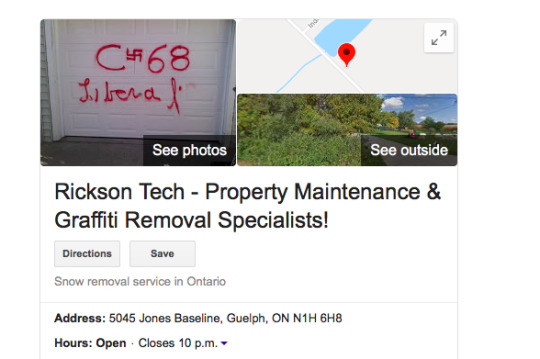
Initially, when I came across the graffiti tech removers online, I assumed graffiti is not appreciated as much in Guelph compared to Cambridge. But at that point, I wasn't aware that Guelph was experiencing hate graffiti and that's why such services were designed. When it comes to hate graffiti no one would appreciate it whether it's home or shop owners. Consequently, shop owners are most impacted by graffiti as business fronts are an easy target mentioned by Paul Deacon in class. Majority of the business owners are unable to pay for extra expenses caused in graffiti removal which is why I've come up with a few ways to prevent this from occurring on a daily basis.
The first approach would be to install surveillance cameras. This would capture any trespassers harming the property in some way. The property owner should arrange the installation of CCTV because it is a secure system for business places and even works to prevent robberies. Therefore, it is a guaranteed investment.

Another approach considered for property owners to prevent unnecessary graffiti installations would be to alter the targeted spaces themselves. There can be two choices either have a rougher surface of the wall to prevent them from becoming easy targets or use anti-graffiti paint. This paint is used primarily in the case of graffiti removal, once this coat is applied graffiti can be easily removed. I wouldn't highly recommend this idea just because the draw and erase trend would continue forever.
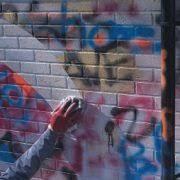

Besides the adjustments that property owners can make. I would recommend having a section of the terms and conditions agreement before a property is rented or purchased familiarizing property owners with solutions, in case their property is vandalized.

I came across this website for the property owners in Vancouver BC, and I am not in favour towards the ideas they have listed that in any case of vandalism the expenses should be covered by property owners. Instead, I think a component of the terms and conditions agreement needs to introduce the Around Town Washdown service as we have here in Guelph. Paul Deacon had mentioned in our class of how surprised property owners are to hear they have access to free services to remove unwanted tagging from their property. This way property owners can contact such services and ask for help.

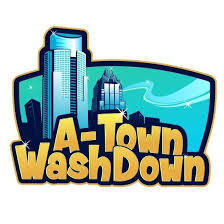
My last recommendation would be for the municipal government. I came across the idea to legalize graffiti and have a wall dedicated to the artists. This would be a great idea because I don't think artists care about the location as much; they want to put something up to present to other graffiti artist or the public entirely. This way the artists will have a place to display their art.

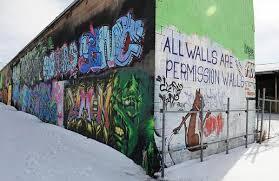
Overall, there will never be an end to graffiti, but I believe these recommendations would be efficient to start with and see if it could work out. I love graffiti, but I can understand how frustrating it can be to see your property being vandalized. There is a place I drive by every day after school, and it's too busy to stop and capture pictures, but I've been noticing that this bridge has new additions of graffiti every other week. And this property of Guelph has just become the graffiti zone, and it's being added to. I feel that if artists stick to one place that would prevent installations on other private property.
Also, I noticed the UC has new art installations regarding the plastic pollution issue! I have attached pictures below in case you haven’t checked it out yet.

http://news.bbc.co.uk/2/hi/2383725.stm
https://vancouver.ca/home-property-development/manage-graffiti.aspx
~Farheen
2 notes
·
View notes
Text
Hi Alex, your blog is really well done!
I agree with your opinion on graffiti, and I view it as a unique form of art as well. I like how you mentioned that location plays a role in determining how the graffiti is recognized. But even more than that its what piece of art we're referring to, whether its the meaningless tagging or beautiful murals.
Also, hate graffiti was widely extended in Guelph previously, which has made it critical to start with some preventative measures to prevent it from re-occurring. The idea to alter the targeted walls for graffiti beforehand would be an effective way as you mentioned. It would also give business owners a chance to add installations related to their business and help promote it. Another similar idea I introduced in my blog was having a rough surface (exterior) to paint on so artists wouldn't bother trying to tag on those walls. Additionally having surveillance cameras would be the best way to capture any vandalists and make them pay for the removal cost. These ideas are not too expensive, and in a way, it's helping the business of the shop owner as well.
I am against the idea that shopowners should be the one paying for any vandalism on their property. For example, I came across this website for Vancouver BC addressing how to deal with graffiti. They mentioned that the cost of removing graffiti would be on the property owners but they'll provide them with free paint. Which is unfair to the owners who set their business up to work on instead of painting their shop walls every time there vandalized. But this website also included the following ideas that we mentioned in our blogs as well:
Apply protective coating on your walls to help with future graffiti removal
Install motion detector lights to discourage vandals
Move vehicles, dumpsters, and other items away from walls
Cover pipes to prevent access to the roof or upper levels of a building
Keep your property tidy
Commission a mural on a persistently targeted wall
So I think these preventative measures can work out! And it would be the most accurate way to address graffiti. Btw: this is the article I was referring to https://vancouver.ca/home-property-development/manage-graffiti.aspx
If you were at the place of a shop owner would you consider these measures, like what would your most preferred action be?
Once again great blog!
Farheen:)
Addressing Graffiti
Graffiti and informal street art are often rather controversial topics in communities. Many people see it as artistic expression that allows individuals to share statements with the world, while many others see it as ugly vandalism. I find myself agreeing more with the side that sees it as artistic expression, but I understand where the people on the other side are coming from. The location of the graffiti is a big factor in this, I find it very annoying and problematic when people paint on local stores or houses. Furthermore, there is some graffiti that is truly harmful to a community and its members, for example, graffiti that insights hate. Hateful graffiti is never acceptable and doesn’t have a place anywhere. With all that being said, how should graffiti be addressed within a community?
I want to start by saying that I do not believe that there is any one solution to addressing graffiti, as it is not that simple. To address graffiti many precautions should be taken, both big and small. I think that preventative measures are a good start, as well as implementing areas into communities where artists are free to spray. These are the simplest, cheapest, and easiest ways to address graffiti in a community.
Preventative measures may include the painting of murals on blank walls and updating the environment in ways meant to prevent crime. Murals on blank walls are a great way to prevent vandalism on these spaces as graffiti artists will not paint over them. This is a rather simple preventative measure, and you will often be able to find volunteer artists willing to paint beautiful murals for free or for a good inexpensive price. On top of the fact that murals are great preventative measures, they make communities look amazing, and are a great way to promote businesses.

source: https://abduzeedo.com/colorful-geometric-graffiti-murals
Now for the slightly more complicated and difficult preventative measures: updating the environment to prevent crime (including graffiti). This can be done in four main ways:
1. Natural surveillance (visibility of area, increased sense of risk, use security cameras, etc.)
2. Natural access control (decrease crime opportunity, hard to access property, etc.)
3. Natural territorial reinforcement (implement design that helps distinguish between public and private property.)
4. Maintenance (Maintenance of property makes it less likely for vandalism to occur.)
These strategies come from CPTED (Crime Prevention Through Environmental Design), a well-known method of crime prevention. These methods should be implemented by both the government on public property and by individuals on their private property. If these steps are taken it is very unlikely that graffiti will occur in this area, and crime, in general, will decrease as well.
source: https://www.torontopolice.on.ca/crimeprevention/environmental.pdf
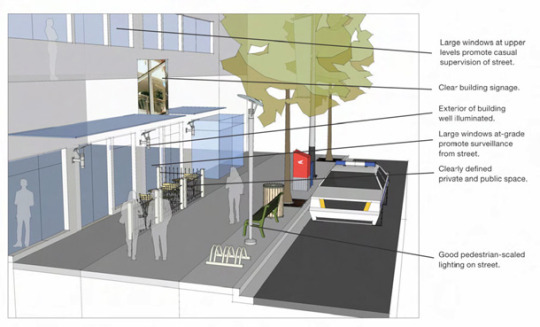
source: http://www.netnewsledger.com/2018/11/26/minister-of-transport-announces-transit-plans-for-ontario/
Once these precautions are taken, there will still be people who want to do graffiti, so I believe that communities would need to implement areas where graffiti is allowed. These areas could be along select bridges, alleyways, long walls, etc. I believe that if anything hateful/extremely offensive was put up, other graffiti artists would have the decency to cover it up. Not only would this address the problem with graffiti, but it would also give communities the ability to express themselves in a way that promotes character and makes them stand out.

source: https://www.blogto.com/arts/2018/06/graffiti-alley-might-be-be-torontos-most-unexpected-tourist-attraction/
-Alex C.
6 notes
·
View notes
Text
Exploring the Expression of Graffiti - extra blog post!!!
Hi everyone!
I know it has been a long time since we had our reading week, but I still, have something to share with you all! So during our reading week, I visited British Columbia for my dentist appointment that is scheduled every other month. (By the way, I am so excited that I am finally getting my braces removed this coming week)!
Since the very first day of this course, I am sure you all can relate that graffiti hasn't left our mind. Even though I wasn't in search of graffiti, I still come across different forms of graffiti that would excite me to the point I have to capture pictures of it! During my visit to British Columbia, a standard way of graffiti that I came across was tagging just random tags on the wooden fenced boundaries of houses. But then I spotted a beautiful art piece done at a bus station near one of the most prominent plazas in Surrey.

I feel this would impact the community of Surrey since the most common form practiced there is tagging which is least attractive compared to this piece. I went there with my cousins, and they weren't aware of this being graffiti as they were constantly bombarded with tagging on their usual route. They considered the floral design piece as a pure art form instead of the picture attached below.

The day I came back from British Columbia I stayed in Brampton at my cousins house and decided to drive to Guelph the next day. On my way back, I came across this art piece in a city named Acton. This is possibly the second largest art installation that I have come across this year! I loved it, and it seems very interesting. I found it attractive even though the artist intended to use dull colours and the surface it has been painted on would have been challenging. I am sure the community of Acton would admire this installation since it's been around for a while! But we can never be sure.

The last installation is one I come across every two weeks on my drive to Cambridge. This installation was also discussed in class by Paul Decon it's on an immense scale of what I call graffiti fonts. I won't go into too much detail as we already mentioned it in class but I wasn't against this mural and neither would the shop owners be since it's on the boundary wall and not their property directly. Although, I found it amusing that someone decided to paint near a bustling road and others followed the trend and added their work.

And thats all I had for today! See you next time:)
~Farheen
0 notes
Text
Legally kidnapped ~ Blog 6
This week's free write is going to be extra special as I will be blogging from the perspective of a graffiti artist myself. Now your probably wondering if I’ve had experience with graffiti before? Before this class I definitely thought I have never done graffiti but if I ask myself Did I ever draw on the tables in school? Yes! Have I ever tried leaving a mark somewhere with chalk whether it's on the sidewalks? Yes! Did I ever leave a tag on someone's wall? Probably not since I am scared to get caught. Somewhere inside I do have the passion of art and think of leaving a mark for others to see.
In the future, if I ever receive the opportunity to participate in graffiti it wouldn't include any tagging or even artsy drawings with spray paint. I am more of a crafty person and would prefer 3D art installations. Referring back to my last blog my art installation would be introduced to raise awareness regarding social issues.

My art installation would be placed in Downtown Toronto to raise awareness for missing children. From the past few days, I have read so much about missing children and we all received the amber alert twice. Keeping in mind were just talking about our area even though there have been many more cases throughout Canada. And just this weekend there was another parental kidnapping. On top of that, another parental kidnapping took place today! This has been so shocking lately and I cannot believe the highest kidnappings are parental! So two days ago I and my mom had a conversation regarding this and she said it is a problem but what can we do? There has been a sudden increase in the rate of kidnappings and children aren't safe with their own family members, forget strangers. So I thought the best way to increase awareness for a problem like this would be through public art installations.

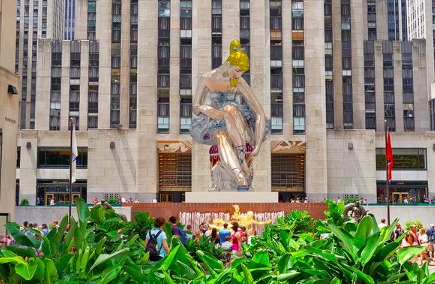
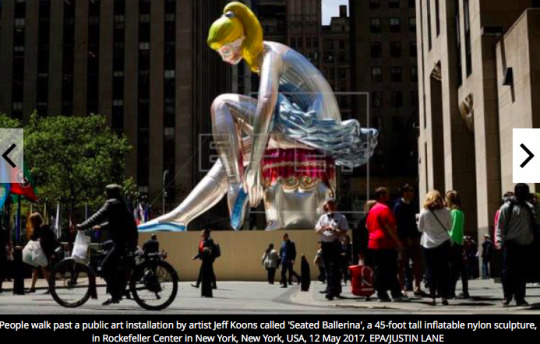
I would be interested in replicating this Ballerina art installation previously introduced in NYC. The work aims to draw awareness to National Missing Children’s Month, in an effort to support organizations like the International Centre for Missing & Exploited Children (ICMEC) that work tirelessly to create a safer world for children.
The sculpture acts as a contemporary iteration of the goddess Venus and symbolizes notions of beauty and connectivity. Its reflective surface mirrors its immediate environment and engages with each viewer. One of the foremost internationally recognized contemporary artists of our time, Jeff Koons earned renown for his iconic sculptures such as Michael Jackson and Bubbles (1988) and his public sculptures, such as the monumental floral sculptures Puppy (1992) and Split-Rocker (2000), both of which were previously installed at Rockefeller Center (NYC). I will also attach these art installations mentioned above there worth a look!
Jeff Koons has really inspired me to create art installations in the future and not just any but to raise awareness for a social issue.
Today when I came from the University I saw my 7-year-old neighbor in the park playing with her dog, that's the kind of safety I want for children in our society.
My question for you: If you were a graffiti artist would you prefer 3D public art installations, green graffiti (eco-friendly graffiti) or spray paints?
What message would you like to share ( address an issue that bothers you the most about our society?



~Farheen
https://www.dw.com/en/seated-ballerina-jeff-koons-unveils-enormous-inflatable-sculpture-in-new-york/a-38825057
Todays kidnapping of 5-year-old (parental)
https://www.ctvnews.ca/canada/amber-alert-cancelled-after-missing-girl-5-found-safe-in-toronto-area-1.4342921

Recent kidnapping and murder of 11-year-old on her birthday (parental)
https://www.ctvnews.ca/canada/first-degree-murder-charge-for-father-of-girl-11-found-dead-after-amber-alert-police-1.4298391
I would also like to share a post that my friend came across and shared with me. It's truly upsetting that someone could be so insensitive for a child.


~Farheen
2 notes
·
View notes
Text
Hey Kaitlyn!
Awesome blog post!
First of all, thank you so much for sharing this new form of graffiti.
Before this class, the definition of graffiti was very limited to me. When I thought of graffiti I thought its the art done with spray paint on random walls. But then I found out that in graffiti there are even art installations, for example, the cannon and how writing on class desks is also considered graffiti, writing in the washroom stalls is also graffiti. And so becoming aware of this new form of graffiti was really interesting.
I am familiar with these installations but not from the perspective of graffiti, as I mentioned my definition was very limited.
I think eco-friendly graffiti will be highly effective and appreciated amongst society. As you mentioned using living moss as a palette eliminates the use of spray paint, paint markers and other paints with toxic chemicals. Something to consider would be this form of graffiti only has advantages and could be used in so many areas to enhance greenery. One quality that I noticed of Guelph was all the greenery so I feel this would be a perfect place, to begin with!
I honestly never thought this form of graffiti could be so convenient to make. I actually did more research and found so many articles on how to make Moss Graffiti. It would be a perfect natural designing tool for the exterior of someones home and even backyard! But In future would you prefer presenting a verbal message through this form of graffiti or use it to raise awareness on a particular social issue? Or just have it as a natural design?
Can't wait to read your next blog!
Farheen
‘Free Write’: Eco-Friendly Graffiti
As I have been exploring and learning about graffiti throughout this semester, I have begun to recognize it everywhere and find it hard not to notice it. As we know, graffiti comes in many different forms, from tagging, to decorative sculptures, to murals. Though forms of graffiti may greatly differ from one another, they all have one thing in common. Graffiti is expressive.
Expressiveness is what every artist and designer strive to accomplish, with the goal of inspiring others with their original works. As a landscape architecture student, I took this course hoping to discover ways to tie the use of informal art into landscape/urban design. I think that a great example of this potential is found in the works of artist Anna Garforth of the UK, who specializes in what she calls “Moss Graffiti”. Talk about original!
Using an earthy element like moss and using it to express a message or a mural definitely catches the eyes of onlookers! Garforth uses moss to create anything from small-scale typography on brick walls to massive geometric designs and patterns with this living material. Below are examples of Garforth’s work in Moss Graffiti.



This work is also called “Green Graffiti” or “Eco-Graffiti” and has clear environmental benefits. Using living moss as a palette eliminates the use of spray paint, paint markers or any other paints with toxic chemicals. Moss Graffiti is eco-friendly and can easily be taken off by spraying natural lime juice onto the design, which reportedly kills moss spores. Also, using moss as a form of public art may help with air pollution. Moss absorbs the “fine particulate matter of air pollution”, reducing the Urban Heat Island effect (when urban areas are hotter than surrounding rural areas).
In addition, using Moss Graffiti on urban brick and concrete walls (the ideal canvas for graffiti artists) may stop unwanted tagging, as moss art is simply too beautiful to distort. Below are some other examples of Moss Graffiti designs from all over the world.



Locally, Julie Forand, former graduate of OCAD University in Toronto was the founder of “Sprout Guerrila”, selling Moss Graffiti kits to encourage people to create art out of moss. She hoped that her product will influence the public to refrain from the toxic paints and chemicals and to bring a new form of graffiti to Toronto in her “I heart my city” campaign. Her kits are $24 each and provide thorough, simple instructions on how to make moss, how to maintain it, and also information on the best places for its growth. Forand says that she doesn’t want to “encourage illegal activity, but street art is amazing, and why not get people involved in making a statement and greening the city”.
With this new-found environmental and eco-friendly form of art, graffiti just got a whole lot Greener.
Sources:
https://www.theglobeandmail.com/life/home-and-garden/gardening/graffiti-in-canada-is-alive-and-well-and-we-do-mean-alive/article14629494/
https://www.permaculture.co.uk/readers-solutions/how-grow-your-own-moss-graffiti
https://www.stencilrevolution.com/blogs/tutorials/moss-graffiti
https://laud8.wordpress.com/2010/12/10/moss-graffiti-art/
6 notes
·
View notes
Text
Make your mental health a priority - Blog post #5

Question for readers:
Mental illness – what do you feel when you hear those words?
When we hear those words, many of us understand it based on our own definitions including personal experience. And perhaps we feel agitated because of the images of mental illness we see in the media. Statistics reveal that one in every five Canadians will have a mental health problem at some point in their lives. This most likely increases once we’re in University and struggle to face everyday situations by ourselves. Most people would believe that mental disorders are rare and “happen to someone else.” Although, mental illnesses are common and widespread as those who appear happy on the outside, may suffocate themselves internally. Mental illness affects males and females, young and old, and is found in every ethnocultural and socio-economic group. Yet, our University is not even close to achieving the level of security that needs to be provided.
Most professors at this University are least concerned about any mental challenges their students may be facing. They believe in keeping everyone equal and in that state, they step back in providing an individual with extra support. Professors happily provide you answers with course-related questions but if something in that course, like your midterm mark, bothers you to point of depression there not able to provide a solution. I believe that stress related to a course can at least be shared with the professors directly as they would know the best solution. The ignorance could be a result of experiencing these problems with so many students making it repetitive.
I would like to share what I was once told by my principle back in grade 7: Every student needs to be treated equally however, each student has different mental capabilities and not providing them with extra support can be harmful to them. My purpose of bringing this up is because in my point of view the failure to do this have become a reason to why our University provides the worst mental health support in Ontario.
Which is why the few art installations ideas I have combined will not only raise awareness but improve mental health conditions in general.
I came across this street art that was placed to promote mental health and I would like to present this picture but in 3D outside every residence of this University ensuring students that it does get better. This would relate to my Kensington car installation from my last blog because it gives features a positive message, is a 3D formation and revolves around nature.

Another contribution would be an interactive art installation consisting of mental health benefits not just for people affected, but also for the visitors to the gallery. It would be a secure space to allow reflection, sharing, understanding, and connection. People who enter this gallery will receive an opportunity to share their stories and talk about what has been beneficial to them in a memorable way - as a light, sounds and video experience. As people walk through the art space, individual light beams through sensor plates would be activated on the gallery floor. Visitors becoming the spotlight - creating an intimate space of connection. Every spotlight would be a different colour to prove my point that every person is DIFFERENT! This entire installation has been created in New York and in case you would like to discover it more there is an article attached below.


My final addition to this proposal would be to allow members of the University to pin their mood status to the wall outside the gallery. This would be beneficial to show the University of what condition the students are currently in. UofG needs to understand that solutions are required rather than defining mental health in programs and other events. They need to provide stronger service as students have to wait several weeks for an appointment with the physiatrist. Meanwhile, this gallery will be beneficial for students until the University decides to make its service more helpful.

The UC is the one place where students and faculty from all programs are together and visit at least once a week, allowing everyone to become a part of this organization. Considering how majority of the students live on campus having a mental health awareness installation outside their residence would be influential. I believe in having different installations because it is unique and also reflects the effort made to propose them. For individuals facing mental challenges, it is critical to show them that we care!
New York art installation:
https://medium.com/healthwellnext/an-art-installation-that-improves-mental-health-2a58a08e8353
UofG abandons students dealing with mental health issues article:
https://www.narcity.com/ca/on/toronto/news/students-are-exposing-the-university-of-guelph-for-abandoning-students-dealing-with-mental-health-issues
~ Farheen
0 notes
Text
Hey Megan!
I absolutely support your idea for this art installation and its purpose. The UC would be a great platform to install this creative idea of yours and this way the majority of the campus including outside visitors are able to see it. The biggest issue all Univerisity students face are the tuition fees and not only that but so many other costs add up like residence + books = $$$$$$Thousands!!!!!
What upsets me the most is how expensive the textbooks are like last semester I spent around $700 on just textbooks!! All the University cares about is making the profit themselves they'll sell textbooks for $20 off compared to the original price and buy it from us only on half price.
OSAP has been beneficial for many students until recent changes were made decreasing the time allotted to pay back loans. As you mentioned as well 6 months were enough for students to pay back their loans after graduation but now it's almost the same with and without OSAP. Students still have to work both in and out of the University. Should a student worry about their academic performance or the monthly costs?
More than that coming to University should be a choice based on your goal and dreams not based on your budget. There is a lot of unnecessary competition among students like there is for grades and now deciding if you can actually afford higher education or not. Like one of my friends is an international student and the only reason she's in college right now is because of the unaffordable University cost.

Is $4000 per semester actually reasonable? Why is it that education is only for those who can afford it?. If one has the potential to learn they should have opportunities otherwise as well.
I think there was a news on how the NDP party if in power would reduce the University fees by 25%, eliminate interest on provincial student loans and provide upfront financial assistance to graduate students. What are your views on this? Do you think it would really happen? If so I bet most of us will be in our 3rd or last year at University honestly.
Anyways thanks for sharing your ideas!!! Great work and your art installation would be perfect. In fact, all the art proposals that our classmates are posting should actually be carried out for real!
Can’t wait to read your next blog:)
Cheers
Farheen
Fight the Fees: Blog Prompt 5

This image was taken from: https://humbernews.ca/2019/02/students-march-province-wide-to-protest-osap-cuts/ which is an article based on the recent changes to OSAP
A message that I personally believe that the University of Guelph should be aware of is the recent change in the Ontario Student Assistance Program. The provincial government of Ontario has decided to make an adjustment pertaining to the length of time that students have to pay back their loans for university or college. Before the recent change, students were allotted 6 months following the time of their graduation from post-secondary school to be able to begin to pay back their school loans. However, the provincial government has decided to cut the 6 months that were previously put in place to help students adjust to life-after-school, and forced them to begin paying back their loans immediately after graduation.
More often than not, when a student enters university they are bombarded with a vast amount of school work, and as a result, they tend to not have a job because of the amount of time that school takes up for them. Once a student eventually finds free time such as during the summer or when they graduate, they attempt to find a job to pay off their loans. Thus the previous 6 months that were allotted to students to begin paying back their loans was quite reasonable, considering the fact that this allows a person to begin working and earning money to pay back the money that they owe.
Reflecting on my previous blog post about the statue Hachicko in Japan, which talked about the solemn story about a dog who had traveled to the train station every day for 10 years following his owner’s death, and as a result, the city of Kyoto Japan creating a sculpture of the dog. The sculpture of the dog seemed to have been carved from a rock. The overall appearance and colour of the statue are quite stark and gray which gives the viewer an abrupt feeling of melancholy.
According to an article, I read called OSAP Applications Rise After Streamlines Student-Aid System, written by the Globe and Mail, there were more than 50,000 students last year that had applied for financial assistance from OSAP. The article can be found by clicking this link: https://www.theglobeandmail.com/news/national/education/osap-applications-rise-after-ontario-streamlines-student-aid-system/article36234322/
An idea that I believe would evoke strong feelings similar to the sculpture I had just mentioned, involves creating a 10″ by 10″ metal cube which includes 50,000 post-it-notes with the different amounts of money that correspond with various students debts pertaining to their school tuition. However, I think that finding out 50,000 different students debts is quite difficult. To make things easier, we could replace the post-it-notes with small lights, potentially multiple strings of Christmas lights that add to 50,000 to represent those students struggling with having to pay for school. I think this sculpture should be displayed in front of the university centre where most, if not all students have to walk by during the day. I think by putting the large cube in a space where many people can see will allow them to become more aware of the recent issues and potentially create discussion and change with this installation.

8 notes
·
View notes
Text
Hi Megan,
First of all, thank you so much for sharing this heart-touching story. Your blog is written very well and making personal connections always makes the post more interesting keep that up! When I first saw your post I had no idea that this would be connected to something tragic.
It made so happy that the people of Japan recognized this dog and his love towards his owner. When it comes to public art installations with an intriguing history it becomes a memorable part of my life. I hadn't heard this story before so it took me a while to actually come out of this and share my views. You're right only the people who have had a dog in their life would understand how it feels when these little ones show their love and care to you in their own ways. Hachi has become an inspiration and has created a special place in everyone's heart!
It was so heartbreaking that Hachi just waited and waited for his owner instead of starting a new life with someone else's family. I can relate to how you feel when Roxy (my dog) was in my life as my only sibling I loved him above and beyond. Sadly, I had to give him away for some reason and I can't think of getting another pet because I can't replace him in my heart just like Hachi was only attached to his owner. Your blog reminds me of this quote that I would like to share:

Can't wait to read your next blog! Well done:)
~Farheen
A Provocative Piece: Blog Post 4
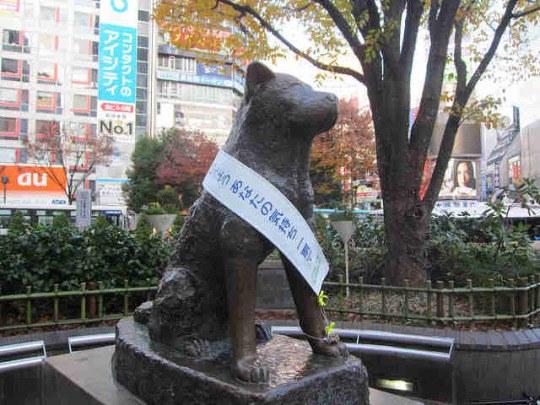
When reflecting back on a piece of informal art that sparks my interest in a heart-warming way, I am reminded of a sculpture of a dog named Hachiko. It is located in Tokyo’s Shibuya Train Station in Japan. Originally, before the sculpture was created, there was a man who bought a dog and named it Hachiko. The man and the dog became inseparable; as the man went off to work Hachiko would follow the man to the train station and wait for him until he returned after his shift. One day at work, Hachiko’s owner unexpectedly suffered a hemorrhage in his brain and died. Since the dog’s owner was unable to return to the train station where his pet would wait, the dog would patiently wait at the train station for hours every day continuously for his ten-year-long life. This became such an inspirational and heart-warming story for the people of Japan due to the dog’s willingness to never give up and remain loyal to his owner that had unfortunately passed away at work.

The following picture above was taken by a local Japanese newspaper of Hachiko. This picture was published in the newspaper to commemorate the loyal dog.
The movie was created in order to recognize this dog and bring awareness to a different culture’s story that they find important. I find that our society often portrays stories on the news that pertain particularly to.
This story has resonated with me since I was young. At an early age, my parents rented a DVD at BlockBuster called Hachiko. When I first watched it, the movie brought tears to my eyes because I was reminded of my own dog and how whenever I used to come back on the bus from my high school, he would wait at the front doors of our house for me to return home, similar to Hachiko. When I would return, he would jump up and down and wag his tail in excitement when he saw me. Unfortunately, since I have moved away to university, I no longer am able to see my dog after a long day at school. My mother still tells me that every day at 2:30, the time when I used to return from high school, he sits at the door and looks out the window waiting for me to come.
I think that people who own an animal, more specifically a dog who waits for them at the door when they are away at school or work will be affected the most by this story.
8 notes
·
View notes
Text
Hi Megan!
Thank you so much for your comments!
I love how you bought up that we have destroyed nature through the use of transportation and that could possibly be what the creators of this Garden Car wanted to express. Despite this car being really famous, there was not a lot of information available. This car is approximately 9 years old and maybe I didn't come across the older articles when it was initially placed in Kensington (2006).
I do believe it has been replaced once as far as I know. I wouldn't say it was destroyed ever because even when it was towed the first time a local restaurant owner brought it back and added the car to his insurance. And after setting a community vote the decision was to keep this car in the neighborhood through summer and spring.
I was amazed as well for the amount of effort not only the creators but the supporters of this Garden Car made. After all, they proved that when graffiti or street art is done for a good cause and even arise awareness it will be highly recognized in society

Heres a picture that I also found of the Garden Car and the model does look different compared to now. The car does get repainted once in a while and is modified if the condition gets worse in any case.
In case you're wondering why it says Community Vehicular Reclamation Project on the car...that is what the car was initially named but is now known as the Garden Car instead.
Kensington’s Garden Car - Blog Prompt 4
When it comes to sharing a meaningful piece of informal art I would refer to the neighborhood known for its fine street art and unusual installations of graffiti, The Kensington Market! Those of you who have visited this section of Downtown Toronto know how it has become a platform to display both graffiti and street art. However, they say that if you haven’t seen the Garden Car then you haven’t seen Kensington. Before I introduce this thoughtful creation here’s a photograph to show you what I am exactly referring to
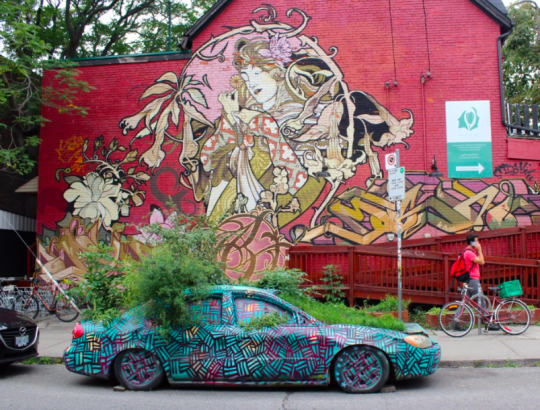
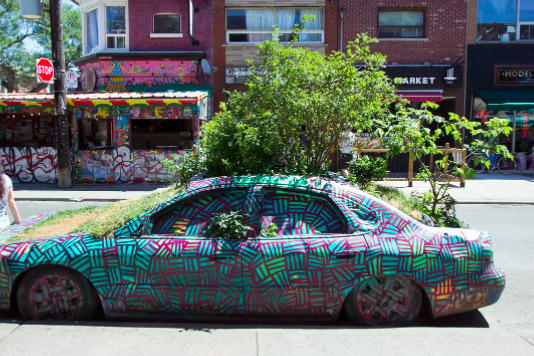
Quotes from a article I recently read:
Children clamber atop the “garden car,” reaching for the burning bush that grows through its rooftop.
Musicians sit on the lawn — once the vehicle’s hood — and play their instruments as awestruck visitors to Kensington Market stop, stare and snap photos. And green-thumbed cooks grow herbs – chocolate mint, rosemary, thyme – out of the vehicle’s trunk.
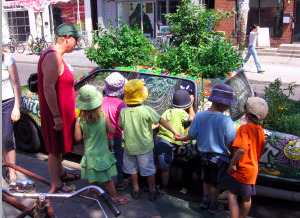
The way this article describes the presence of this Garden Car, it significantly represents the connection of people towards this piece. The reason I am sharing this is that the way society feels for an artwork determines its true meaning and appreciation. This impacts all age groups as the Garden Car is admired by children, adults, and seniors. It’s far away from the messy tagging and is known to be one of the top 10 “Toronto street art spots to snap your next Instagram photo.”
This public art installation was originally in front of the La Palette restaurant, where it had been since its creation in June 2006. Initially, its creators didn’t know if it would be permitted to remain on the street but continued feeding the parking meter. The car was towed away once, but Amlani (co-owner of the restaurant) had it returned. On another occasion, when a tow truck showed up, the car’s supporters formed a human chain link around it. Because this beautifully designed car is considered public art, it required liability insurance, which for a long time was covered by La Palette’s insurance company. At a point, this restaurant was closing its marketing location which meant this car would have to find a new home. Luckily this little piece of downtown was quickly embraced by her new uptown neighbors, and much appreciated by the seniors who preferred gardening in a raised bed.
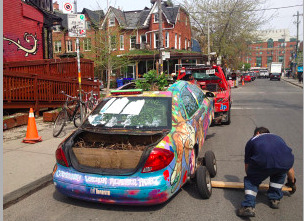
With the help of the local Councillor and the support of the Toronto Parking Authority, the parking fees were waived as long as this car would be removed during winter months to avoid interference with snow trucks.
Coming to know about the effort the community made to keep this car in the area was unbelievable. As I mentioned this car would go into its hibernation during the winter and the people around would be so concerned about where the car is going and if they’ll bring it back or not. This car does get repainted with different artwork once in a while so don��t be surprised if you don’t exactly see this when you go there. The location of this car does vary around the neighborhood but you can always find its address online. Currently, this Garden car is at:
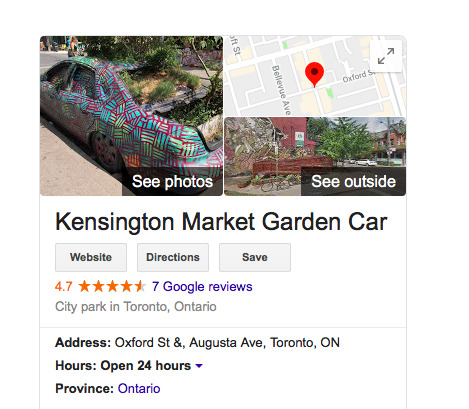
Eventually, an artwork gains meaning before or after and in the case of the Garden Car, it surely is a positive production. As I mentioned before this car drastically differs from messy tagging as it is a combination of a mural on a motor vehicle enhancing nature and its beauty. This is the first public art invention that has acted as a tool of environmental outreach. This Garden Car reminds me of the cannon at UofG because they both are moveable objects displaying a wide variety of murals and quotes. The creators have effectively used a scrapyard four-door sedan (possibly a dodge spirit) festively painted and filled with soil to deliver the message of using public space to enhance greenery. Not only that but creating art from scrap requires a lot of thought and hard work after all the artist has to transform something worthless to worthy. This installation of public informal art is currently my favorite and no I haven’t seen this car in person even though I have been to Kensington market (where I had my first interaction with graffiti).
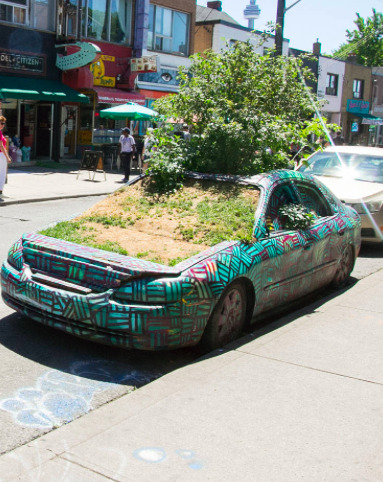
Thank you so much for spending your time to read my post! Feel free to add some pictures of your favorite street art and share your views on the Garden Car below:)
Sources:
https://www.thestar.com/news/gta/2010/10/27/kensington_markets_garden_car_to_roll_once_more.html
https://matadornetwork.com/life/10-best-public-art-spots-toronto/
http://yvonnebambrick.com/2014/05/17/happy-9th-birthday-kensington-market-garden-car/
~Farheen
5 notes
·
View notes
Text
Kensington’s Garden Car - Blog Prompt 4
When it comes to sharing a meaningful piece of informal art I would refer to the neighborhood known for its fine street art and unusual installations of graffiti, The Kensington Market! Those of you who have visited this section of Downtown Toronto know how it has become a platform to display both graffiti and street art. However, they say that if you haven't seen the Garden Car then you haven't seen Kensington. Before I introduce this thoughtful creation here's a photograph to show you what I am exactly referring to


Quotes from a article I recently read:
Children clamber atop the “garden car,” reaching for the burning bush that grows through its rooftop.
Musicians sit on the lawn — once the vehicle’s hood — and play their instruments as awestruck visitors to Kensington Market stop, stare and snap photos. And green-thumbed cooks grow herbs – chocolate mint, rosemary, thyme – out of the vehicle’s trunk.

The way this article describes the presence of this Garden Car, it significantly represents the connection of people towards this piece. The reason I am sharing this is that the way society feels for an artwork determines its true meaning and appreciation. This impacts all age groups as the Garden Car is admired by children, adults, and seniors. It’s far away from the messy tagging and is known to be one of the top 10 "Toronto street art spots to snap your next Instagram photo."
This public art installation was originally in front of the La Palette restaurant, where it had been since its creation in June 2006. Initially, its creators didn’t know if it would be permitted to remain on the street but continued feeding the parking meter. The car was towed away once, but Amlani (co-owner of the restaurant) had it returned. On another occasion, when a tow truck showed up, the car’s supporters formed a human chain link around it. Because this beautifully designed car is considered public art, it required liability insurance, which for a long time was covered by La Palette’s insurance company. At a point, this restaurant was closing its marketing location which meant this car would have to find a new home. Luckily this little piece of downtown was quickly embraced by her new uptown neighbors, and much appreciated by the seniors who preferred gardening in a raised bed.

With the help of the local Councillor and the support of the Toronto Parking Authority, the parking fees were waived as long as this car would be removed during winter months to avoid interference with snow trucks.
Coming to know about the effort the community made to keep this car in the area was unbelievable. As I mentioned this car would go into its hibernation during the winter and the people around would be so concerned about where the car is going and if they’ll bring it back or not. This car does get repainted with different artwork once in a while so don't be surprised if you don't exactly see this when you go there. The location of this car does vary around the neighborhood but you can always find its address online. Currently, this Garden car is at:

Eventually, an artwork gains meaning before or after and in the case of the Garden Car, it surely is a positive production. As I mentioned before this car drastically differs from messy tagging as it is a combination of a mural on a motor vehicle enhancing nature and its beauty. This is the first public art invention that has acted as a tool of environmental outreach. This Garden Car reminds me of the cannon at UofG because they both are moveable objects displaying a wide variety of murals and quotes. The creators have effectively used a scrapyard four-door sedan (possibly a dodge spirit) festively painted and filled with soil to deliver the message of using public space to enhance greenery. Not only that but creating art from scrap requires a lot of thought and hard work after all the artist has to transform something worthless to worthy. This installation of public informal art is currently my favorite and no I haven't seen this car in person even though I have been to Kensington market (where I had my first interaction with graffiti).

Thank you so much for spending your time to read my post! Feel free to add some pictures of your favorite street art and share your views on the Garden Car below:)
Sources:
https://www.thestar.com/news/gta/2010/10/27/kensington_markets_garden_car_to_roll_once_more.html
https://matadornetwork.com/life/10-best-public-art-spots-toronto/
http://yvonnebambrick.com/2014/05/17/happy-9th-birthday-kensington-market-garden-car/
~Farheen
5 notes
·
View notes
Text
Hey Claire,
Great post!!! At first, I would assume that graffiti was removed in Guelph just because people don't appreciate this form of art but after some research, I realized that hate graffiti has been extended a lot, especially in Guelph. A lot of the property owners are upset with the vandalism of their shops like you mentioned. No one wants to spend extra money just because of someone who doesn't value their privacy and feelings. I believe that a lot of people have just given up the idea that graffiti would come to a stop. I feel that Guelph has both supporters and opposers for graffiti and it all depends on what piece we look at. No one wants to see inappropriate texts and images in the area they live in so they stand against it. However, Guelph has already initiated towards introducing public informal art to our society from the projects that you mentioned.
I personally don't agree that our University should put much effort towards introducing graffiti in the public. Just because this is a topic of endless debate that might be taken in favor but also against the University and its reputation. Until the point that this introduction towards informal art stays on campus would work best? The Jazz Art Festival was a great step to give people a better understanding of what graffiti actually is and I think they should continue that but on a greater scale. No one would be forced to attend them but when it comes to having a fair in the city a lot of people are attracted and will most likely bring back a lot of new information. But besides that I agree with you for everything else, most importantly your blog was very interesting and fun to read thank you so much for that. I like the way you presented your research from the articles you read. Can't wait to read your next post!
Cheers,
Farheen
Graffiti in Guelph: Celebrated or Detested? (Blog #3)
The argument over whether or not graffiti should be an integrated aspect of a communities’ landscape and culture is widespread and varied from city to city. There will always be community members who view graffiti as a distasteful eyesore; vandalism that is destroying the beauty and integrity of their home. In contrast, are those who believe graffiti to be a beautiful and necessary form of artistic expression that brings excitement and vitality to a community. As a whole, the latter seems to speak more to the city of Guelph’s stance, as there is a sense of open-mindedness with the matter, rather than strict policy or banning of graffiti altogether. However, after doing some digging, I found evidence that not everyone in the city holds this same opinion.
In 2018, an article was posted on guelphtoday.com detailing the second annual “Around Town Wash Down” of graffiti and tags in the area. When Paul Deacon, who I’m assuming was a key figure in the wash down operation, called a local businesswoman to inform her they would be removing the graffiti from her building for free, her gratitude nearly brought her to tears. According to the article, “She had owned the business 15 years and she was very upset at what had happened to the building, but couldn’t afford to fix it”(Armstrong, 2018). With this in mind, I think it’s safe to say that a majority of those who oppose graffiti in Guelph, are the owners of private property. Subject to defacement, these property/business owners find their buildings being targeted, and consequently their property/ businesses being harmed in the process.
Decon, however, goes on to say that he believes “graffiti” tends to have a negative connotation, and he is actually a fan himself of the more artistic pieces. “Our job is to get rid of the bits and pieces people don’t want and that they can’t afford to get rid of,” he said. “I have approached people and some have said they are not bothered (by the tagging). If someone has identified they are upset by it, we do something.” I believe this is a fair and just way of dealing with those who are unhappy with the tags on their property. It is, after all, private property and they have a right to cover up whatever graffiti they find unpleasant. But it is also made clear by Deacon that not everybody is against graffiti, even tagging.
Continuing on in my research, I found plenty of articles and initiatives working to cultivate and spread appreciation for graffiti and public art in Guelph. For example, in 2015 the “Mural of Hope” project was executed, calling together a group of local mural and graffiti artists to cover up a wall of hate-filled messages and images. They did so by creating a collaborative and beautiful piece, with the motive of expressing what Guelph actually represents, that is, positivity and compassion for one another. Additionally, in 2018 Guelph held a “Street Art Walk” lead by local graffiti artist Arthur Kerry, allowing locals to experience an interactive walking tour of the vibrant public art found downtown, as well as become educated on urban, street, and found arts. There’s even a current call for mural artists on the City of Guelph’s website, “inviting artists and artist collectives with exterior mural experience to submit their credentials, examples of prior experience and a preliminary vision for the development and execution of one of four site-specific, outdoor murals along Wilson Street” (City of Guelph, 2019).
Clearly, Guelph does an amazing job at raising awareness for the cultivation and appreciation for street art; an appreciation that is seemingly growing each year. If I were to propose an initiative to increase the visibility/awareness of public art in Guelph, I would begin with the University. Guelph is a university city, and therefore the university itself could possibly be the greatest platform for getting the message out. I would organize an event in which students, as well as locals, could get involved in creating a grand, collaborative mural that borders the university, or at least a portion of the university. Although ambitious (perhaps too ambitious), I think that this would be not only an amazing bonding experience for those living in Guelph but also a beautiful statement of pride, bringing together the creative minds and artistic visions of Guelph locals. Those who participate would be able to experience first hand the freedom and enjoyment involved in producing a creative piece of work for others to admire and cherish.

From the 2018 “Around Town Wash Down”. Source: https://www.guelphtoday.com/local-news/volunteers-with-paint-brushes-and-rollers-will-cover-up-some-of-the-graffiti-and-tags-this-friday-961587


From the Guelph Street Art Walk. Source: https://www.facebook.com/pg/guelphstreetartwalk/photos/?tab=album&album_id=2128368990511983
CURRENT CALL FOR MURAL ARTISTS: https://guelph.ca/living/arts-and-culture/special-projects/main-street-mural-project/
Mural of Hope: https://www.guelphmercury.com/news-story/5699375-guelph-graffiti-wall-to-be-transformed-into-a-mural-of-hope/
5 notes
·
View notes
Text
What’s Graffiti for Guelph?
Welcome back to my new post on exploring the expression of graffiti!
The offensive tagging and vandalism, especially in the alleyways of Downtown Guelph, has always been an unresolved issue amongst society. With such a disputable issue in the community, two rivals are likely to form. In the case of Guelph when it comes to hate graffiti, it has been opposed to a wide extent and its removal is addressed as a priority task.
As I mentioned in my previous blog post there was an ongoing battle along one of the most popular walking trails here in Guelph. Previously, the wall that runs parallel to Speed River, just north of Eramosa Road had a chaotic assortment of what many found to be vulgar and discriminatory graffiti. But the process of removal had begun shortly after the complaints of pedestrians who viewed this graffiti as an offensive content and a visual eyesore. Parts of the wall that had hate crime were first covered with a coat of white primer and then with a dark brown undercoating, followed by a criss-cross plaid pattern. Keeping in mind that the front section of this wall, closest to Eramosa Road, had a bright work of mural art left untouched.
As this course began so did my research on graffiti particularly in Guelph, I came across several articles seeming to oppose graffiti “Around Town Wash, Down will be out covering graffiti and tags on Friday” and even “Volunteer group tackles unwanted graffiti tags for Guelph businesses.” At first, I assumed the City of Guelph was taking unnecessary action towards graffiti and informal art. However, after reading these articles I came to know how positive Guelph is towards creative wall art. Volunteers would only remove graffiti that was posed towards someone's business or private property. To the level hate graffiti had extended in Guelph this was certainly the best thing to do.
In the article “Great graffiti wall goes plaid” from 2016 Sain Metwey, a local community activist who organized the Murals of Hope project shared how disappointing it was to see work being done by a crew of commercial painters and not a group of artists. She was not thrilled by the criss-cross plaid pattern as she addresses, “I’m disappointed that it’s plaid, “There are so many very talented artists in Guelph. It’s too bad they couldn’t have done something more artistic with the wall” (GuelphToday.com). Sian Matwey had proposed the idea of having a section where artists from Guelph can work on a project together and that everyone can be proud of. In fact, the coordination and fundraising manager for the Murals of Hope program operated out of the Royal City Church downtown was given the approval to transform the colorful and sometimes offensive graffiti on the 300-foot riverside wall into something a little more inclusive.
https://www.guelphtoday.com/local-news/great-graffiti-wall-goes-plaid-353376
This area seems to be where property owners have allowed graffiti to remain despite all the actions taken in the past few years against it


Overall, society as a whole has both opposed and supported graffiti depending on how the graffiti looked. When it comes to racist and homophobic, as well as sexually violent in nature texts and images it is rejected by the vast majority of citizens in the community. However, the beautifully painted graffiti can be appreciated as well.
If I were to propose an initiation towards increasing the visibility or awareness of informal public art I would start from the University of Guelph. Guelph isn't a big city but is well known because of our University and all the students who come from different places to be a part of this institution. Although our University has done it’s best with having a course designed on exploring the expression of graffiti, we also have the cannon, sounding board and the previous facility of a complete wall dedicated to our artists. I believe if the University was to pursue opportunities beyond this point would be problematic, as some people dislike graffiti and might question the Universities reputation.
In that case, my second and most suitable option would be to continue the “Street Art Walk” earlier lead by Arthur Kerrey a local street artist as part of the Guelph Jazz Festival. In my opinion, this was the beginning of introducing informal art in this society but it wasn’t as popular as the one in Cambridge. A few days back my friend mentioned the graffiti festival they have in Cambridge Downtown every year, graffiti artists from all over the world are welcomed to present their artwork. The international street art festival also allowed graffiti and chalk artists to permanently install art components. This for sure was a bigger event organized in the City of Cambridge. In comparison, if we were to search graffiti in Cambridge a lot of interesting articles are revealed, whereas for Guelph the first thing we would see is Graffiti Removal Tech.
https://www.guelphmercury.com/community-story/8904197-guelph-graffiti-gallery-photos-of-street-art-from-downtown-street-art-walk/
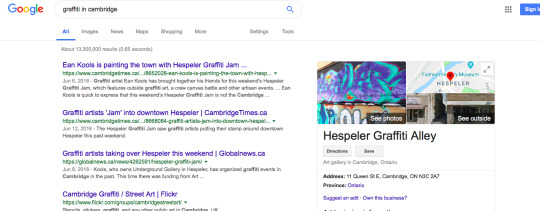
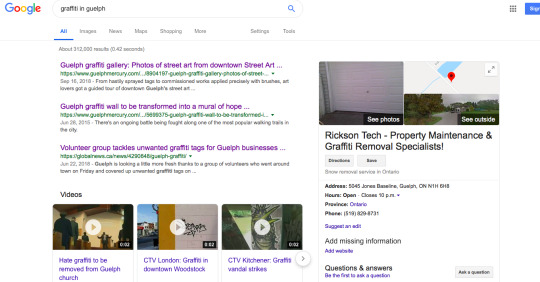
Below are a few pictures of the Cambridge Graffiti Fair that my friend took



2 notes
·
View notes
Text
Known to be Unknown artists in the alleyways of Guelph Downtown
Welcome Back, Everyone!
Today out of all the provinces I have lived in throughout my life I choose my favourite of all Ontario. Now I am originally from Brampton but I haven't encountered a lot of graffiti in Brampton itself but more towards Downtown Toronto, and to base, this blog from Downtown Toronto would be no different to base it off of my new home Guelph.
I went out for a little investigation before this blog to discover public art and graffiti, and I came across a lot more than I expected in such a small area. To begin with, being asked to discover public art in an unfamiliar city where you would consider looking first? Now from experience, we can officially accept that graffiti is most often found behind old buildings, railway tracks and even bridges drawn over a river. But to compare the most commonplace of public art would be the alleyways of Downtown in every city. Downtown is from where the roots of a community begin, and these areas are generally crowded and in rush hour from morning to night.
The exact intersection of Woolwich and Eramosa in Downtown had the widest variety of multiple styles of graffiti (tag, easy, wild-style, throw up, sake etc.). Previously this entire wall behind the apartment building and city’s plazas roughly 100-meter long, four-meter high wall was the receptacle for a chaotic assortment of what many found to be vulgar and discriminatory graffiti. Parts of the wall that had hate crime was first covered with a coat of white primer and then with a dark brown undercoating, followed by a criss-cross plaid pattern.
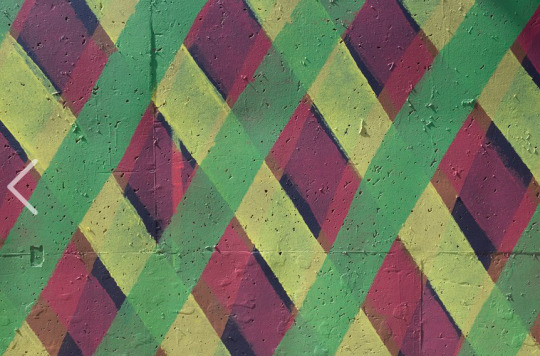
However, not all the wall had been whited out the front section closet to Eramosa road had a bright work of mural art done in the past by children and youth and remains to be untouched until the day I saw it.
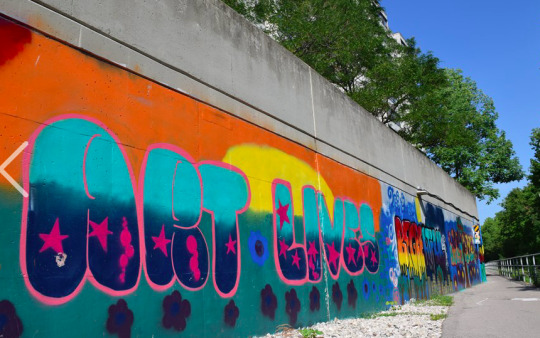
Recently it came to my attention that the main difference between graffiti artists and public art installers is simply their intention. Graffiti writers are not interested in the general public understanding their artwork. They are primarily concerned with other graffiti writers who can decipher the coded tags and appreciate the style of the writing. However, both of these pieces of art are found at similar locations. Public art is art in any media that has been planned and executed with the intention of being staged in the physical public domain, usually outside and accessible to all. Graffiti is normally unplanned and viewed at hidden paces but also easy to view areas.
I know it’s hard to accurately predict the unknown artists behind this massive graffiti in Downtown of Guelph, but I believe the range would be from 14 - 27 year old. The few possibilities of that are because frequently children and young adults hold grudges against the law, for a reason or another they want to show that nothing is going to stop them from illegally spray painting someone's private property. Now, this statement I would mainly use to describe all the forms of graffiti towards the extreme left side of Eramosa where there was a lot tagging, abusive language one over the other, although very few positive words. The extreme right side of Eramosa has more public art since 2016 and was decided to remain untouched.
Guelph is generally a safe place to live and has fewer criminal acts than Brampton so it’s hard to indicate that the vandalism form of graffiti occurs in the areas full of crime. Young teens would often choose a location where they are not easily caught. For an example the location I visited for this blog was by a railway line with a sidewalk for pedestrians on one side and river on the other, where the art displayed would catch a lot of attention. Although, towards the left vandalized side of Eramosa road had graffiti behind tree bushes or the ceiling of the concrete wall. For a long time, I believed that graffiti is done only by young teenagers to vandalize property but later on, I figured that there are professional graffiti artists too and this has become a form of art with its wide range of styles. The demographics show that the two main groups of public art installers/graffiti are quite common in every city one are the rebellions just making their way for risk and adventure whereas some genuinely try to display their artsy skills. Work done by both graffiti and public art installers can be attractive it just depends on the style and message delivered. These two groups were separated at this particular location in Downtown where I noticed that all the unpleasant graffiti was to one side and the visually attractive art towards the other.
This area in the city seems to be where property owners have allowed graffiti to remain despite all the actions taken in the past few years against it. I came across a few articles that graffiti in Guelph is a problem that is never going away and they commonly assume these unknown artists are children or youngsters. It felt nice to know that Guelph appreciated the artsy side of public art and decided to keep it in Downtown, however, all the vigorous discriminating graffiti has no place in our country at all.
Left side of Eramosa and Woolwich:



Right side Of Eramosa and Woolwich:

0 notes
Text
Hey Kaitlyn! First of all well-written blog, I enjoyed the variety of informal art/graffiti that you have included. I believe you had mentioned this unusual bicycle tree in class as well and from then on I wish I had seen such unique variations of graffiti. It seems like Milton has a wide variety of graffiti that spreads positive vibes as well. I never thought the purpose of this bicycle tree would turn out to be a representation of a social fundraising program. This is possibly my first encounter with graffiti that is aside from spray painting on walls. As I mentioned earlier, Milton reflects the positive side of graffiti more which genuinely makes me happy. I believe me and mom have driven by/near Trafalgar several times, and it's not a busy area where most people would stop by, I am going to make sure that I don't miss this form of art from next time. I agree that most graffiti artists are young teenagers and I believe the age would range from 14-27-year-old because there are just so many possibilities of why they would be involved. For example, to rebel against laws, leave a mark, overcoming stress, to prove something, or to show off their artistic skills. Have you ever thought about adding on some graffiti at your school earlier? I look forward to reading your next blog!!
Informal Art in my Hometown
I have lived in a small village by the name of Brookville for the past 10 years, a rural village between Milton and Guelph. There are limited shops and buildings in this area besides an elementary school, a convenience store, a gas station, a butcher shop and a veterinarian clinic. The population in this town is mainly made up of either families with young children or older couples who are usually retired. In my many years living in this area, I have not been exposed to graffiti.
In a more populated town like Milton, where I went to high school, graffiti is commonplace. I must admit that I never really noticed the significant amount of graffiti found in Milton until I was actually looking for it. At my high school, Milton District, graffiti is found on the sidewalks, on the portables, on the soccer field posts and even on the exterior walls of the school. Students have recently been afforded the freedom to cover the interior walls of the school in art with the permission of head staff. Being surrounded in this environment for 4 years, I have never considered this form of art to be ‘graffiti’. It gives the school character and I have always had an appreciation for it. Having created a mural for the school, one may say that I am in fact a graffiti artist!
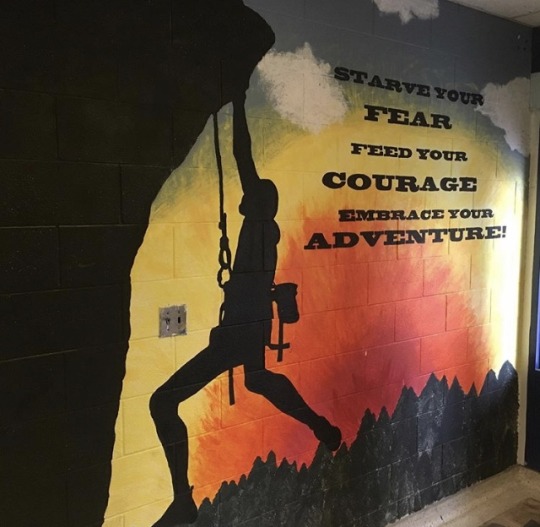
The piece of Wall Art above is found in the Outdoor Education wing in my school.
Mill Pond, in downtown Milton, is a graffiti ‘hotspot’. I understand that the abandoned train tracks, the iron bridges and the pathways must be a very intriguing creative space for graffiti artists to paint without being caught by authorities. I believe that these informal art installers are teenagers or young adults, either looking at graffiti as a way to rebel against the law or to express themselves by making their creations in a public area.
Below are pictures that I took of some graffiti found at Mill Pond park.



In addition to the young teenagers and adults using graffiti as a means of creative expression, there are residents in surrounding areas using this art form to promote awareness toward issues close to their heart. On my way to high school each morning, I often passed this ‘bicycle tree’ on 15th Side road at Trafalgar Road.

Source: https://www.theifp.ca/news-story/5373439-pedaling-against-poverty-to-raise-funds-for-impoverished-women/. (link to article if interested).
This willow tree is a statement for “Pedalling Against Poverty”, a charity that raises funds for impoverished women in Nicaragua and was used to promote a bicycle charity event taking place in November 2018. The resident established this fundraiser in 2003. The property that the tree is located on is on a bend in the road and people often pull over to take pictures and admire this art form. There are even people who decide to donate their old bicycles to be a part of this magnificent creation!
Our perception of what is considered ‘graffiti’ is evolving, with the younger generation encouraged to express themselves creatively. Graffiti artists like Banksy are appreciated and glorified and with this change in perception there may be an increased use of graffiti in a range of demographics (i.e., from young to old, from rich to poor) to market products and businesses. One could say that the graffiti artist is in all of us!
3 notes
·
View notes
Text
Hey Nicole, To begin with, I love how you made a personal connection towards your interaction with graffiti. You made a high point about how art does not have a language. I brought this point up in my blog as well that we do not need a description with any artwork to understand the purpose attached to it. A lot of other things such as colour, layout and even personal connections like you mentioned explain lots. I can relate with you because as a child I could never realize the actual effort behind graffiti what shaped my perspective were all the negative drawing and words. I regret that because till now I would have had the best collection of graffiti. From two years I have been obsessed with having wall art as the background in my pictures. I am glad it did evolve as there was much more to see on my visit to Downtown Toronto. Art is one way for an individual to share their story without using any language (I just loved this explanation of yours)! It took a while to understand that the artists behind this simple art are trying to show us something. I mean why else they would choose to display their work in public like this rather than in exhibitions. Some don't even take the credit by signing off their work but stick to a specific style which can be challenging. I look forward to reading your next blog!! You made this very interesting and fun to understand most importantly.
The First Time Graffiti Meant More to Me Than Just Street Art
Hey guys it’s Nicole…
I’m kidding, I can’t tell you how many times people say that to me when they first meet me even though I have never even seen that video!
However, now that I have your attention, I would like to officially introduce myself! My name is Nicole Amodeo and I am in the Applied Human Nutrition program here at the University of Guelph. I love learning about nutrition and how it affects us both individually as well as on a global scale. My main appeal to nutrition is malnutrition world-wide as I incorporate courses in International Development, which I hope to minor in, as my electives. I love travelling and giving back to society in any way I can. In fact, after our first lecture I reflected on graffiti around the world and came to my first realization: we speak many different languages to communicate around the world, but art is something that universally has the same language. More specifically, when I went to Spain last May I could hardly pick up any Spanish, but I was able to appreciate the art. I was able to do so because you don’t need to translate art from a specific language, but instead look deeper into the meaning. Of course different cultures have different ways of looking at things, but at least you can understand the meaning without the hassle of translation. Speaking of Spain, this was the place that graffiti meant more to me than just art. Realizing that this experience was less than a year ago, makes me wonder about all of the other graffiti I have passed by but have never given any serious attention or put thought into. Instead of focusing on the greater meanings behind street art, I turned my head as I let some of the profanity-related graffiti get to my head before realizing the other side. I focused my eyes on all the thorns instead of on all the beautiful roses. Although I had gone 18 years without being mindful of these masterpieces, I am glad I eventually saw the deeper meaning. Specifically, I went to Spain in May to visit my brother, who was just finishing his third year of university abroad, before I went to a wedding in Italy a week later. Taking the train year-round to class, my brother passed graffiti daily. He always said that he couldn’t wait for me to come visit him so he could show me something. The last day we spent in Spain my brother took my sister and I to hike the ‘Siete Picos’ (the Seven Peaks in Madrid). On the 2-hour journey to get to our destination, we took a train passing many concrete walls and bridges covered in graffiti. Before we passed the informal art, my brother explained to me that on his way to his first day of school he passed graffiti spelling the word ‘MONGE’. A side note about the word monge: ever since I was a kid, my brother called me Monges due to a series of events. The story behind the name is nothing big; however, people are always asking about the meaning. He went on to explain that every day when he went to school, he thought of me and felt as if I was with him despite the 6-hour time difference keeping us apart. Even if the word, illustrated in graffiti, only caught his attention because of my nickname, it has somehow stuck with me ever since. It was in that moment when I passed the graffiti the first time, that I started to recognize the deeper meaning behind informal public art. Unfortunately, I bet the ‘MONGE’ that was illustrated did not mean what I thought when I saw it; however, it was after that first encounter that I noticed that word the whole train ride to our destination. In fact, I was able to take a picture, seen attached to this post, as we passed one of the illustrations. Like I mentioned earlier in this post, I didn’t need someone to translate another language to me, but instead I interpreted it on my own. We all have our own interpretations, making us who we are to be. As you may see, my first experience with graffiti was nothing but a connection I made with my nickname; yet, I am proud to admit that since then, I have experienced more connections with graffiti due to that initial process.
Thank you for spending time reading my story and I hope you can make the same realization wherever you are next.
Until next time,
- N.A

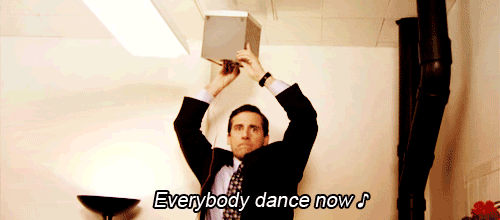
5 notes
·
View notes
Text
Beginning to Explore Graffiti
Hi Everyone,
Welcome to my very first blog! I look forward to meeting you all this semester:)
To begin with, my name is Farheen Dhaliwal currently enrolled in the biological sciences program here at Guelph. My hometown is Brampton; however, I recently moved from British Columbia. I lived in B.C. for about a year and graduated from high school. The most interesting fact about me is that I never stayed at a place or school for more than two years. You all know how important it is not to move around while your in university and in that case I am excited to spend four years at UofG.
I have no idea about where and when my first encounter to graffiti was because graffiti and informal art is everywhere and if you spot it day to day it does not remain an attraction any longer. Although as a child, I never understood the thought and skill behind this artistic work. I became obsessed with graffiti in about grade 10 when we had a school trip to Downtown Toronto and came across this wall covered with so many colours and patterns as you'll see at the bottom…
Figure 1


This sight was impossible to ignore! Having artistic skills is definently a talent and after personal experience my perception towards graffiti changed over time. As I mentioned earlier, during my childhood graffiti was just pure vandalism of private property in my understanding. I believe it was the same for my parents as well yet it does depend on the layout and colours used. We don't necessarily require a description with any piece of art because we all up till some point can assume the purpose behind it. For instance colours really matter as they have some sort of application (Red is the color of fire and blood, Green is the color of nature, Yellow is the color of sunshine) and so on. Both children and adults specially admire 3D wall paintings. Two days ago I found this graffiti behind a building at a plaza near my house as shown below...
Figure 2

You can tell that no one would probably want to stand in front of this wall and take pictures. Some pieces can look quite hideous and a sign of disrespect while the other half can be admiring.
A tag is a primary form of graffiti and a style for street artists to sign their name anonymously. They may include initials, symbols or even random words and then embellish them with stars or crowns. Another popular form is known as a Throw-up, which is composed of imperfection using two or three colors. Throws up are usually weak on the aesthetic scale since they are created roughly. Which according to me would describe figure 2.
My second heart touching interaction with graffiti was back in B.C., our school animal was husky and just behind the building it had this masterpiece.

Figure 3

Now that we're all starting to explore graffiti and it's expression it's critical to read the artists mind and purpose behind the work they choose to create in certain places. The following are a few questions that come in my mind and my possible explanations to them. Feel free to add on your responses in the comments!

What places is graffiti spot at the most? Crowdy places like downtown Quiet places like bridges above a river Behind buildings
Can the location of graffiti affect a viewers opinion? If you see a wall under the bridge that says “Art is not a crime” for an instance then, of course, you would think its hideous and a sign of disrespect. However, when we see the same graffiti at an art park, the public will admire how simple yet beautiful this piece is and take pictures with it.
What is the purpose of street art? Possibly the ignorance of one’s art skills A way to overcome stress Express their feelings Leave a mark
I am not fond of drawing, but I wish I had the skills to do so. I understand the fact that graffiti is beautiful for the most part and is someone's way to express their story.
Overall, Legal or illegal, graffiti is art, found everywhere. I believe its time to look at graffiti with a creative eye and not with the idea of vandalism. Yes, the person might not have taken permission to spray paint some random wall, but we cannot ignore the creativity behind graffiti. After all, art does not have to be legal to be considered art.
10 notes
·
View notes